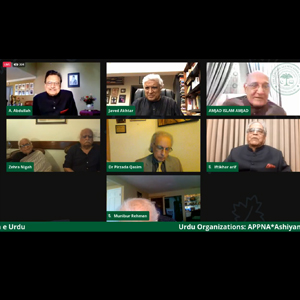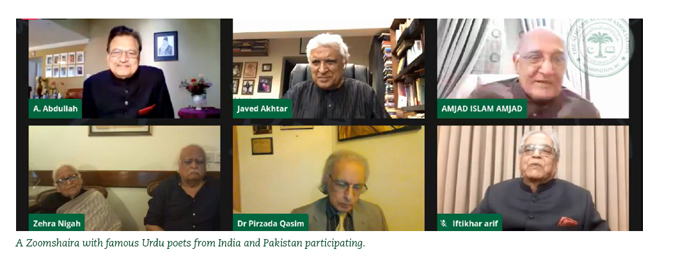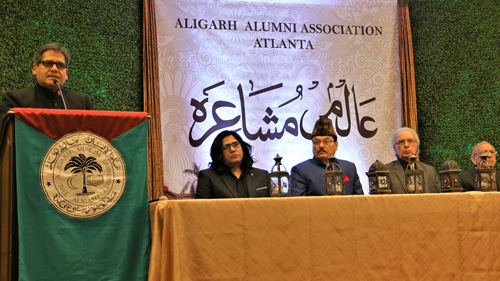Trends: Zoomshaira: Not Just a New Name for Traditional Mushaira

Can virtual mushairas replace the traditional form, letting the audience and poets enjoy the immersive poetry experience that has been the hallmark of these conclaves?
Like many other cultural events that have moved online due to the pandemic, the Urdu lovers have also adopted this change and are now holding virtual mushairas and shaayari nashists—as poetry conclaves are called in Urdu. Now that the mushairas are mostly held over Facebook Live or Zoom, dare we give them a name and call them zoomshaira? But it is not just change in the name that these times have provoked. Having been involved in hosting international mushairas in Atlanta for 20 years, I am in a position to observe many differences between in-person and virtual mushairas.
It is generally accepted that there are four elements of any mushaira: the poets, the audience, the host or nazim-e-mushaira, and the setting or things which create the ambience such as sound, light, hall, etc. Every element is equally important for the complete success of a mushaira. Each mushaira is also unique. A successful poet in one mushaira may not necessarily receive equal applause and compliments in another. So, it is sometimes said that mushairas are like bazaar-e- Misr or bazaar of ancient Egypt, where betting on success is unpredictable.

In zoomshaira, while all those elements are needed too, the audio setting and the internet connectivity are the most important factors. They can make or break the mushaira. So, the nazim-e-mushaira has a huge role in ensuring that not only do they have good connectivity and audio quality, but also that the participating poets do as well.
Compared to traditional mushairas, the poets in zoomshaira are very selective in reciting their kalaams or poetry. They tend to recite what they feel is their best composition, not necessarily the most popular ghazal or nazm, the two popular poetry forms, unless specifically requested. In traditional mushairas, hosted in front of a live audience, poets enjoy playing to the gallery and reciting their most popular kalaams. Either way, the quality of shayari and tarannum or musical composition on display in zoomshaira is no lesser than that of traditional mushairas.
A good aspect of zoomshaira is that young and new poets get to share the platform with renowned and senior poets on equal footing and receive the same kind of attention. It surely gives newcomers a lot of encouragement.
The most noticeable missing element in zoomshaira, however, is the audience’s chorus of applause, the resounding wah wah! Absence of that deprives the poets of the most needed connection with the audience. Even though you can comment and send feedback through chat box, it can’t replace the traditional applause replete with frequent shouts of muqarrar, irshad, shandaar, bahut khoob, wapas aayiye, etc. As the famous Urdu poet Ameer Minai said:
sha¯.er ko mast karti¯ hai ta¯ri¯f-e-sher ‘ami¯r’
sau botaloñ ka¯ nashsha hai is vaah vaah meñ
(Poet gets intoxicated with applause for the couplet, Ameer / Oh! the word of praise carries the thrill of hundred bottles of wine).
It doesn’t look like technology will ever be able to fill this gap. This major disadvantage will probably stay. For the audience too, the virtual mushaira gives a more academic ambience rather than one of entertainment. Due to technical reasons, and also to avoid background noise, most of the audience are put on audio mute mode. This gravely limits their participation.

[Left] A traditional mushaira in Atlanta from pre-Covid times.
Zoomshaira has certain advantages though. First, online scheduling forces zoomshaira to start and end on time, compared to traditional mushairas which have been notorious for starting and continuing till late. Many poets who, due to visa restrictions, health concerns, or other reasons cannot travel, can now participate in mushairas through Zoom. We recently attended a virtual mushaira where a famous 96-year-old poet participated. We also saw some poets who rarely share the platform with others agree to share dais on virtual setting. With everybody staying home, the poets have also run out of excuses to decline any mushaira invitations due to scheduling or traveling conflicts. Zoomshaira definitely has made their accessibility possible.

On the monetary side too, holding mushairas are much cheaper through Zoom. The travel, housing, hall, and publicity costs are saved. The attendees also don’t have to pay much to register and, in many instances, it is totally free. Interestingly, though, the attendance is much lower as compared to the hundreds thronging in traditional mushairas. The apparent reasons could include limitations on how many people can join the Zoom call, and also many enthusiasts still feel these remote mushairas can’t fully entertain in all their elements. Some people probably prefer to watch the recorded version instead of live feed, like other YouTube uploads.
An unintended aspect of the virtual mushaira is that we sometimes get to see poets’ libraries and living style, which was virtually impossible in pre-pandemic time. It could inspire us, or conversely make us a bit judgmental of them. Another change with the zoomshaira is the timing of the event. Some mushairas are now held in the daytime because of time difference in one part of the world to another. It has also broken the national boundaries and is truly becoming international, both in poet and audience participation. Also, zoomshairas are much more easily recorded and digitally saved. These will be much easier to retrieve and view in the future.
The zoomshaira has its advantages and disadvantages. Certainly, it can never replace the traditional version. However, even after the pandemic, the zoomshaira is here to stay as an alternative in some situations. Regardless, this phase of literary activities and events will certainly be preserved like no other.
Rasheed Ahmad, Ph.D. is an environmental engineer by profession. He is an alumnus of AMU, IITK, and Georgia Tech. He works with an international engineering company in Atlanta.
Enjoyed reading Khabar magazine? Subscribe to Khabar and get a full digital copy of this Indian-American community magazine.
blog comments powered by Disqus












